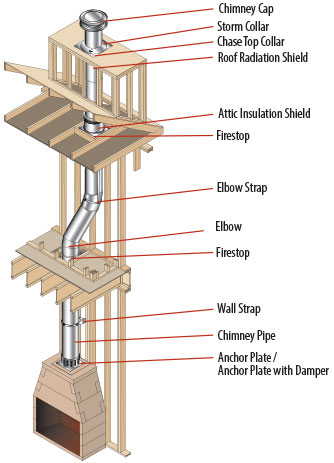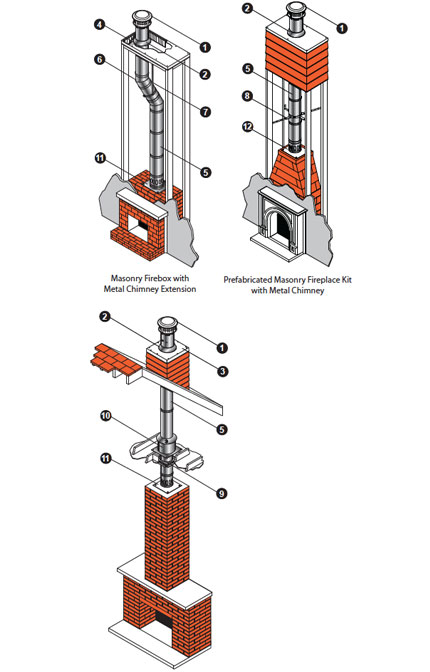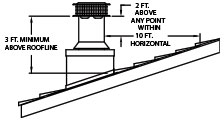Applications
DuraChimney II is a double-wall, air-cooled chimney system for use with masonry fireplaces which burn wood, oil, coal, or gas.
Materials and Construction
.016" 430 stainless steel inner wall and .021" galvanized steel outer wall. For stainless steel outer wall, contact Customer Service.
Unitized pipe sections. No field assembly of inners and outers required.
Clearances
2" clearance to combustibles.
Shrouds
UL Listed with DuraVent shroud specifications. Information available online at www.duravent.com or call and request L181.
Diameters
10", 12", 14", and 16".
Listings
UL Listed to UL 103 and ULC S604 standards (MH7399).
Refer to our Typical Installation drawings to select the appropriate component parts for your installation.

More Typical Installations:

| Installation Key |
| 1 | Chimney Cap |
| 2 | Storm Collar |
| 3 | Chase Top Flashing |
| 4 | Roof Radiation Shield |
| 5 | Chimney Section |
| 6 | Elbow |
| 7 | Elbow Strap |
| 8 | Stabilizer |
| 9 | Firestop |
| 10 | Attic Insulation Shield |
| 11 | Anchor Plate |
| 12 | Anchor Plate with Damper |
| 13 | Supplementary Support |
| 14 | Wall Strap |
Planning Your Installation:

The following recommendations are a general guideline to assist in the layout and selection of the chimney components needed for your installation. Always follow DuraVent Installation instructions enclosed with the cap or support box before installing your chimney system. Installation instructions can be viewed online at www. duravent.com, under catalogs and instructions.
- Measure the diameter of the fireplace flue outlet. An improperly sized chimney results in poor draft and excessive creosote formation.
- Select the chimney with the same size diameter as the fireplace flue outlet. Refer to the chimney sizing chart in the back of this catalog for masonry fireplaces.
- Install the chimney in an enclosed chase.
- If possible, avoid offsets. A straight vertical installation is more efficient and less likely to develop creosote. If an offset is required to avoid rafters or other obstructions, measure the horizontal distance required and the vertical height available. Both 15° and 30° elbows are available. Elbows greater than 30° are not allowed in the United States. Two offset (four elbows) in a single installation is permitted. Refer to the offset chart in the back section of this catalog. At least one Elbow Strap is required. Elbow Straps ensure adequate support.
- Determine the minimum chimney height above the roof line. Building codes require a minimum of 3' above the roof penetration and at least 2' higher than any portion of a building within 10'. See figure 1. The termination cap is installed above that point.
- Chase Top Flashing is available. A pitched roof flashing can be locally made, if required. A storm collar is required for all installations using a flashing.
- Determine the total length of chimney required for the installation. To calculate the installed per length of 10"-16" DuraChimney II pipe, subtract 1" per joint. Minimum recommended chimney height, at sea level of straight vertical chimney, is 10' to 15' above the fireplace outlet. Higher elevations, or the use of elbows, will require approximately 30% to 60% more height to provide for an adequate draft.
- For a UL approved shroud, see the DuraChimney II Shrouds Installation Instructions (L181). View online at www.duravent. com, under catalogs and instructions.
- Be fire safe. Maintain at least 2" clearance to combustibles. Follow local building codes and have your chimney inspected by a certified professional.
Catalogs:
Installation Instructions:
Sales Sheets
Bulletin